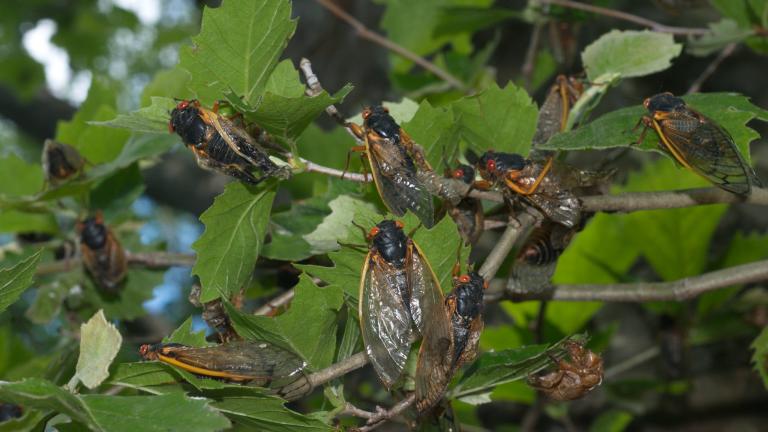 A colony of ants formed their own life raft, seen in Hickory Creek Preserve in Will County. (Courtesy of Meagan Crandall)
A colony of ants formed their own life raft, seen in Hickory Creek Preserve in Will County. (Courtesy of Meagan Crandall)
Parts of the Chicago area are still drying out after a line of concentrated downpours dumped more than half a foot of rain Sunday on the southern reaches of the region.
Among those recovering from the damage to their home: ants.
Meagan Crandall stumbled across a colony flooded from their nest in Mokena’s Hickory Creek Preserve, while out for a walk shortly after the rain ended.
The mass of wriggling critters — looking a bit like a heaping bowl of caviar if caviar had legs — stopped her in her tracks.
“I had no idea what this was at first. I knew it was some kind of insect because the pile was moving, but I couldn’t tell what they were,” Crandall told WTTW News. “I thought maybe ants or spiders. But I’d never seen them grouped up like that before!”
She shared a photo to the Will County Wildlife Facebook group, asking for help with an ID. The verdict from commenters — apart from one person's response of “That is a great big pile of keepitthehellawayfromme” — was split almost 50-50 between ticks (and a call to “burn it”) and ants.
Andy Suarez, a specialist in ant ecology and behavior at the University of Illinois, ruled definitively in favor of ants.
If their nests become waterlogged, ants will evacuate — workers, queen and eggs — and form a waterproof ball that floats on the surface until the waters recede and they can move back in or build a new nest.
It’s a “somewhat common but habitat-dependent” adaptation most typically seen in ants that live in floodplains or along the banks of rivers or streams, Suarez said.
Some species of ants, like the winter ant (Prenolepis imparis), build wide-ranging nests that burrow as deep as 12 feet underground, he said, and can ride out a storm. But “others are nesting really close to the surface” and survive by becoming their own life preserver, said Suarez.
Depending on the type of ant — and there are some 15,000 described species, 100 of which are found in Illinois — a colony can number from dozens to tens of thousands. Researchers at the Georgia Institute of Technology have led much of the scientific study into floating ant balls and determined a minimum of 10 ants are needed to form a stable raft.
It’s a phenomenon that went viral back in 2017 when a reporter in Houston tweeted video of floating fire ants flushed out by Hurricane Harvey.
Media outlets made hay with the story, with headlines that ranged from sensational to borderline hysterical (in both senses of the word): “Floating fire ant island will make your skin crawl,” “Floating Venomous Fire Ants Add to Threats in Hurricane’s Wake,” “Terrifying ‘Rafts’ of Stinging Fire Ants Are Now Floating.”
Instead of being disgusted, how about asking, “Gee, how did they evolve to do that?” Suarez said. But “it’s hard to get around (people’s) knee jerk reaction” of being creeped out by insects, he said, which in general get a bad rap as pests.
For the record, there are no fire ants in Illinois, Suarez said. Our homegrown colonies are not only “quite harmless,” they’re incredibly valuable in terms of ecosystem services like soil aeration, he said.
“The problem is, people aren’t exposed to nature as much as they used to be,” said Suarez. “When I grew up, I had a prairie. Now it’s the Elgin-O'Hare (expressway).”
Pro tip: Don't touch the floating fire ant colonies. They will ruin your day. #Harvey pic.twitter.com/uwJd0rA7qB
— Mike Hixenbaugh (@Mike_Hixenbaugh) August 27, 2017
Contact Patty Wetli: @pattywetli | (773) 509-5623 | [email protected]








